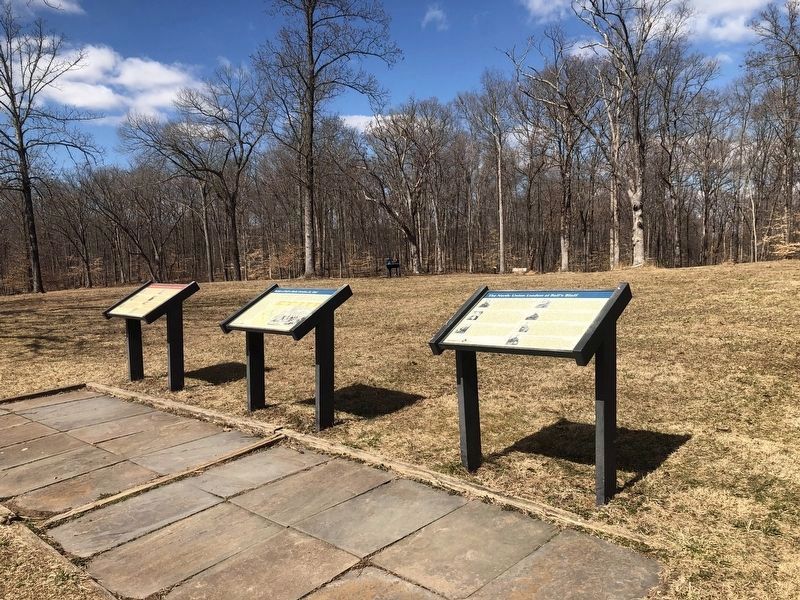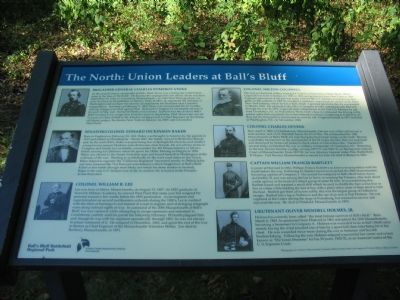Leesburg in Loudoun County, Virginia — The American South (Mid-Atlantic)
The North: Union Leaders at Ball's Bluff
Brigadier General Charles Pomeroy Stone
As the overall commander of Union forces at Ballís Bluff, Stone was a rising star in the Union army at the time of the battle. He became the scapegoat for the defeat. Stone was born September 30, 1824, in Greenfield, Massachusetts. An 1845 West Point graduate, he won two brevets for gallantry in Mexico. Early in 1861, he organized the defenses of Washington and oversaw security arrangements for President-elect Lincolnís inauguration. Arrested on February 8, 1962, Stone was incarcerated for six months with no charges ever filed against him. Released in August, he eventually served on the staff of Maj. Gen. Nathaniel Banks in Louisiana. Typhoid and the cloud of Ballís Bluff resulted in his resignation from the army in September, 1864. Stone later served 12 years as Chief of Staff to the Khedive of Egypt and as Chief Engineer on the Statue of Liberty project. He died in New York on January 24, 1887, and is buried at West Point.
Senator/Colonel Edward Dickinson Baker
Born in England on February 24, 1811, Baker was brought to America by his parents in 1815 and settled in Philadelphia. About 1827, the family moved to Belleville, Illinois and, by the mid-1830s, Baker was practicing law in Springfield where he and another young lawyer named Abraham Lincoln became close friends. He served two terms in Congress and briefly but creditably commanded the 4th Illinois infantry in Mexico before moving to California where he spent the 1850s. Moving to Oregon in 1859, Baker helped to organize the “California Regiment” (recruited mostly in Philadelphia and later renamed the 71st Pennsylvania Infantry) which fought here at Ballís Bluff. Killed at this battle (though most likely not where his stone marker is located), Baker is the only U.S. Senator ever to die in combat. He is buried at the Presidio in San Francisco.
Colonel William R. Lee
Lee was born in Salem, Massachusetts, on August 15, 1807. An 1825 graduate of Norwich Military Academy, he entered West Point that same year but resigned for personal reasons a few weeks before his 1829 graduation. As an engineer and superintendent on several northeastern railroads during the 1850s, Lee is credited with the ideas of burning coal instead of wood in engines and of stringing telegraph wires along railroad rights of way. In command of the 20th Massachusetts at Ballís Bluff, Lee was captured while attempting to escape upstream and remained in Confederate custody until his parole the following February. Ill health plagued him and, though he was with his regiment sporadically through 1862, he was not always in actual command of it. He resigned in December, 1862, and spent the rest of the war

Photographed By Devry Becker Jones (CC0), March 6, 2021
2. The North: Union Leaders at Ball's Bluff Marker
Colonel Milton Cogswell
The only professional soldier among the Federal commanders at Ballís Bluff, Milton Cogswell was born in Indiana in 1825 or 1826 and graduated from West Point in 1849. Cogswell spent most of the pre-war years with the 8th U.S. Infantry at various western posts. In the summer of 1861 he accepted a volunteer commission as a colonel of the 42nd New York Infantry which he led at Ballís Bluff. Captured late in the day, he was paroled in March, 1862. He returned to the 8th U.S. Infantry in 1863, remaining with that unit through the war. In 1869, Cogswell took a detachment of the 21st U.S. Infantry by rail from Charleston, S.C. to Promontory Point, Utah where he witnessed the driving of the golden spike that completed the transcontinental railroad. Continuing to California, he thus led the first party to travel coast to coast by rail. Cogswell retired in 1871 and died in Washington, D.C., in November, 1882.
Colonel Charles Devens
Born April 4, 1820, in Charlestown, Massachusetts, Devens was a Harvard lawyer, a state senator, and a U.S. Marshall before the Civil War. He commanded the 15th Massachusetts at Ballís Bluff, his men being the first Union troops on the field. Devens is probably best known as the commander of the XI Corps division that was surprised and destroyed by Stonewall Jacksonís flank attack at Chancellorsville. Transferred several times, he finished the war as military commander of Charleston, S.C. Returning to the law, Devens became a judge, serving 1873-77 and 1881-91 on the Supreme Judicial Court of Massachusetts. From 1877-81, he was Attorney General under Pres. Rutherford B. Hayes. Fort Devens, Massachusetts is named for him. He died in Boston in 1891.
Captain William Francis Bartlett
A junior at Harvard in 1861, William Francis Bartlet was known to sympathize with the South before the war. Following Ft. Sumter, however, he joined the 20th Massachusetts, becoming captain of Company I. He crossed his company to Ballís Bluff before dawn on October 21 and was among the last to leave, re-crossing the Potomac after dark about a mile upriver at the head of a mixed group of some 80 men. In accomplishing this, Bartlett found and repaired a small skiff which he used to shuttle the men across four or five at a time while holding the rest at bay with a pistol when some of them tried to rush the boat. Bartlett got all of them across safely; this was the largest group of Federals to escape. Bartlett lost a leg at Yorktown and the use of an arm at Port Hudson. He was captured at the Crater during the siege of Petersburg, but returned to service and survived the war. He died in Pittsfield, Massachusetts, in 1876.
Lieutenant Oliver Wendell Holmes
Holmes has correctly been called “the most famous survivor of Ballís Bluff.” Born March 8, 1841, he graduated from Harvard in 1861 and joined the 20th Massachusetts, becoming a lieutenant in Company A. Holmes was wounded twice at Ballís Bluff; once mearly having the wind knocked out of him by a spent ball, then later being hit in the chest. He was wounded twice more during the war at Antietam and Second Fredericksburg. Following the war, Holmes enjoyed a successful law career and is best known as “The Great Dissenter” for his 30 years, 1902-32, as an Associate Justice of the U.S. Supreme Court.
Erected by Ball's Bluff Regional Park/Northern Virginia Regional Park Authority.
Topics and series. This historical marker is listed in this topic list: War, US Civil. In addition, it is included in the NOVA Parks series list. A significant historical date for this entry is January 24, 1887.
Location. This marker has been replaced by another marker nearby. It was located near 39° 7.915′ N, 77° 31.673′ W. Marker was in Leesburg, Virginia, in Loudoun County. Marker could be reached from Ballís Bluff Road, on the left when traveling east. Located to the west of the National Cemetery in Ballís Bluff Regional Park. Touch for map. Marker was in this post office area: Leesburg VA 20175, United States of America. Touch for directions.
Other nearby markers. At least 8 other markers are within walking distance of this location. First Black Combatant of the Civil War (here, next to this marker); The South: Confederate Leaders at Ballís Bluff (here, next to this marker); Battle of Ball's Bluff, October 21, 1861 (here, next to this marker); a different marker also named The North: Union Leaders at Ball's Bluff (here, next to this marker); Thomas Clinton Lovett Hatcher (a few steps from this marker); 13 Pounder "James Rifle" (a few steps from this marker); Clinton Hatcher (a few steps from this marker); A National Cemetery System (within shouting distance of this marker). Touch for a list and map of all markers in Leesburg.
More about this marker. The marker displays portraits of General Stone; Colonels Baker, Lee, and Devens; Captain Bartlett; and Lieutenant Holmes.
Regarding The North: Union Leaders at Ball's Bluff. This marker is one of a set along the Balls Bluff Battlefield walking trail. See the Balls Bluff Virtual Tour by Markers link below for details on each stop.
Related marker. Click here for another marker that is related to this marker. This marker has replaced the linked marker.
Also see . . .
1. Staff Ride Guide for the Battle of Balls Bluff. Contains more details of the leaders engaged in the battle. (Submitted on August 31, 2007, by Craig Swain of Leesburg, Virginia.)
2. Balls Bluff Battlefield Virtual Tour by Marker. Over twenty markers detail the action at Balls Bluff and related sites. Please use the Click to map all markers shown on this page option at the bottom of the page to view a map of the marker locations. The hybrid view offers an excellent overlook of the park. (Submitted on November 11, 2007, by Craig Swain of Leesburg, Virginia.)
Credits. This page was last revised on March 7, 2021. It was originally submitted on August 31, 2007. This page has been viewed 1,947 times since then and 30 times this year. Last updated on October 8, 2020, by Bradley Owen of Morgantown, West Virginia. Photos: 1. submitted on September 1, 2007, by Craig Swain of Leesburg, Virginia. 2. submitted on March 6, 2021, by Devry Becker Jones of Washington, District of Columbia. • J. Makali Bruton was the editor who published this page.
